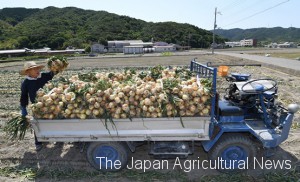
All nominsha for onion farmers on Awaji Island come with large platforms, but they have different shapes and functions. (on Awaji Island, Hyogo Prefecture)
Hyogo, Oct. 1 — Awaji Island in Hyogo Prefecture is famous in Japan for its onions, and there on the island, you’ll see a lot of unusual-looking vehicles called farmers’ cars or nominsha in Japanese, custom cars which are built at local iron works by hand-assembling automotive parts and components taken from used automobiles.
One of the distinctive features shared by all nominsha vehicles is its extraordinary mobility. This is created by combining extra large tires taken from construction vehicles and engines from used passengers vehicles so that the drivers can go up and down easily across the ridges. No other vehicle can drive directly in the onion fields for farmers to load a significant amount of onions, a lot more than how they can do with usual light-duty trucks, and take them to warehouses designed to dry onions.
Most of the farmers in the southern part of the Island, where onion production is popular, have the farmers’ cars. Ikuo Yamaguchi is a 68-year-old onion farmer from Minami-Awaji town. “With the farmers’ cars, we can work on wet, muddy fields even after the rain. They are as tough as the tanks and last for decades,” he said.
Currently, there are approximately 4,000 nominsha vehicles working on the island. All of them were built at local iron works by assembling second-hand engines, gearboxes, and drivetrain on the steel frames welded at their factories. Each vehicle’s width, colors, and functions are customized to meet the needs of each farmer. Each car costs around 1,000,000 yen to 15,000,000 yen.

All nominsha for onion farmers on Awaji Island come with large platforms, but they have different shapes and functions. (on Awaji Island, Hyogo Prefecture)
The nominsha was introduced in the early 1960s, formerly as something simpler that worked with agricultural power generators. However, they have continued to evolve with the addition of functions such as a four-wheel drive unit, a lift and a dump units on their platforms.
Kazuya Emoto, 71, runs one of the pioneering iron works, Emoto Tekko, which still makes the nominsha. “So far, I’ve built more than 2,000 nominsha vehicles. I once made 130 of them a year,” he said. He also said that his nominsha was shipped to some of the Okinawa islands to help sugarcane farmers on the remote islands.
However, the growing popularity of Japanese used cars abroad has lead to a lack of second-hand automotive parts and components in Japan. As a result, the number of nominsha production is now on a decrease. “The one I’m working on now will be the last one I can build,” Emoto said.


